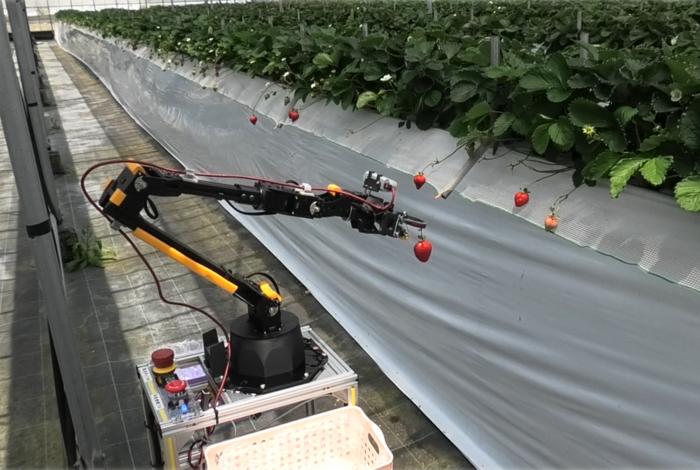
In the realm of modern agriculture, one of the most persistent challenges involves the labor-intensive task of harvesting delicate fruits such as strawberries. While these fruits remain in high demand worldwide, the workforce capable of performing the physically demanding work needed to pick them is steadily diminishing. In response to this issue, researchers at Osaka Metropolitan University have made significant strides towards advancing agricultural robotics by developing an innovative autonomous navigation method tailor-made for robots operating within high-bed cultivation environments.
High-bed cultivation, a technique that elevates planting beds above the natural ground level, provides certain ergonomic advantages by reducing the strain on human laborers. However, even with this improvement, harvesting strawberries, tomatoes, and other delicate produce still demands intense manual effort and dexterity. Recognizing this, Assistant Professor Takuya Fujinaga and his team embarked on designing a robotic system capable of autonomous navigation along these raised beds to perform harvesting tasks reliably and efficiently.
Central to this breakthrough is the integration of lidar (Light Detection and Ranging) technology into the agricultural robot’s navigation system. Lidar sensors work by emitting laser pulses and measuring the time it takes for the light to reflect off surrounding objects, creating highly detailed three-dimensional representations known as point clouds. Originally developed for applications such as autonomous vehicles and advanced smartphone sensing, lidar’s precision allows the farming robot to accurately perceive and map its environment in real-time, a critical requirement for maneuvering tightly spaced rows and uneven terrain characteristic of high-bed fields.
The newly developed algorithm empowers the robot to move autonomously in two primary modes: first, navigating to predefined target locations such as specific cultivation beds or harvesting zones, and second, dynamically following the contours of the raised beds while maintaining an optimal, consistent distance. This dual-mode operation ensures the robot can navigate complex farm layouts efficiently while minimizing potential plant damage and maximizing harvesting accuracy.
To validate their approach, the research team conducted rigorous experiments both in simulated virtual environments and in actual agricultural fields. These experiments demonstrated that the robot could maintain stable movement along the beds, even when faced with irregularities in bed height, terrain undulations, or obstacles. The precision enabled by lidar mapping substantially outperformed traditional GPS-based navigation methods, which often lack the spatial resolution necessary for the intricate work of picking fruits delicately situated on raised beds.
Beyond the impressive feat of autonomous navigation, the implications of this technology for farm management are profound. As Professor Fujinaga elaborates, robots capable of precise movement around cultivation areas open the door to a broad range of agricultural automation beyond harvesting. These include real-time disease monitoring through sensory data, targeted pruning to promote plant health, and even the potential for precision fertilization or irrigation. Together, these capabilities can transform the labor dynamics of fruit cultivation, addressing workforce scarcity while improving operational efficiency.
The convergence of advanced robotics, lidar sensing, and sophisticated navigation algorithms exemplifies the emerging era of smart agriculture. As these robots become more practical and commercially viable, farms employing high-bed cultivation can expect a revolution in how planting, maintenance, and harvesting are conducted. Reduced reliance on manual labor not only elevates worker safety and reduces physical strain but also contributes to more sustainable farming practices by optimizing resource use and minimizing crop damage.
Moreover, the research by Osaka Metropolitan University contributes to a broader societal goal: increasing food security amid rising global demand and labor shortages. Automation technologies capable of operating autonomously in complex farming environments represent a critical step forward in meeting these challenges, ensuring that high-value produce like strawberries remains accessible while cutting costs and environmental impacts.
The academic findings presented by Professor Fujinaga and his colleagues have been published in the reputable journal Computers and Electronics in Agriculture, highlighting both the technical rigor and practical relevance of their work. The publication outlines the algorithmic framework, sensor integration methods, and experimental validations that underpin the autonomous navigation system, serving as a valuable resource for engineers and agricultural scientists striving to build next-generation robotic farming solutions.
As the robotics field continues to evolve with advancements in artificial intelligence and sensory technologies, the integration of such systems into traditional farming practices will likely accelerate. The ability of robots to perform complex tasks in constrained environments with minimal human supervision stands to reshape the agricultural landscape fundamentally. Notably, the system developed for high-bed cultivation environments demonstrates the importance of tailoring robotic functionality to specific crop and field conditions, moving beyond one-size-fits-all solutions.
Looking forward, the success of this autonomous navigation approach invites further research into enhancing robot adaptability and versatility. Integrating additional sensory modalities such as hyperspectral cameras or thermal imaging could enable the robot to perform even more nuanced monitoring, such as detecting early signs of disease or water stress. Coupling these capabilities with machine learning algorithms offers the potential for continuous improvement in task execution and decision-making based on accumulated environmental data.
In conclusion, the pioneering research from Osaka Metropolitan University showcases a promising future where autonomous agricultural robots guided by lidar technology transform labor-intensive strawberry harvesting into an efficient, precise, and scalable process. This advancement holds the potential not only to mitigate labor shortages but also to usher in a new era of smart, sustainable agriculture equipped to meet the food production demands of tomorrow.
Subject of Research: Not applicable
Article Title: Autonomous navigation method for agricultural robots in high-bed cultivation environments
News Publication Date: 13-Feb-2025
References:
Fujinaga, T., et al. “Autonomous navigation method for agricultural robots in high-bed cultivation environments.” Computers and Electronics in Agriculture, 2025. DOI: 10.1016/j.compag.2025.110001
Image Credits: Osaka Metropolitan University
Keywords: Autonomous navigation, agricultural robots, lidar technology, high-bed cultivation, strawberry harvesting, precision agriculture
Tags: advanced agricultural engineeringagricultural automation solutionsautonomous farm roboticsergonomic advantages in farmingharvesting strawberries with robotshigh-bed cultivation methodslabor shortage in agriculturelidar technology in agriculturemodern farming challengesprecision agriculture innovationsrobotic navigation systemsrobotics in crop harvesting





